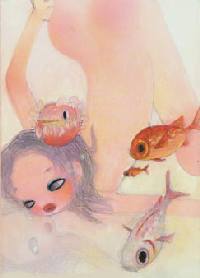|
'21701792622','japart','art');
//-->
The contemporary art in Japan is naturally influenced by the world contemporary art. But the power of the Japanese traditions, the oppressive presence of a dense urban environment and the various traumatism undergone by Japan for 60 years (defeat of 1945, Hiroshima, earthquakes, economic crisis, etc.) involve a production very rich, original and little known. Some examples, paintings, sculptures, photographs, classified very arbitrarily by broad topics: All the artists - A modern vision of the traditional arts of Japan - A rather classic geometrical abstraction - A popular art influenced by mangas and vidéos - The obsessional presence of the city and the technique - The difficult search for an identity At first, "kawaii" means "cute".I The culture in Japan of taking delight in cuteness has
dimensions that go far beyond infantilism or immaturity. This "cute" tendency is marked by the pink colour, which
prolongs the universe of the dolls, the candies and the flowers. |
|
|
Takashi Murakami (born 1962 Tokyo) The artwork of Takashi Murakami draws from the language
of popular and traditional Japanese culture to comment on their
relationship to contemporary life.
|
|||
|
Minako Nishiyama ( b 1965, Hyogo) She is a striking representative of the tendency " kawaii " of the Japanese popular art from 1990.
|
Aya Takano is born 1976 in Saitama.
|
||
|
Naoko Yurikusa (尚子 百合草) Naoko Yurikusa is born in Nagoya, 1975.
|
Sako Kojima (サコ 児嶋) Sako Kojima is born 1976 in Kyoto.
|
||
|
Visit Japan( in
french)
|








